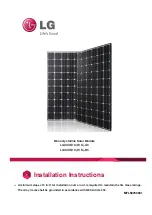
| 9
the SS toothed nut. A wrench may be used to do this.
The tightening torque is 3-7 Nm (2.2-5.2 ft-lbs).
6.0 MOUNTING INSTRUCTIONS
·
The mounting design must be certified by a registered
professional engineer. The mounting design and proce-
dures must comply with all applicable local codes and
requirements from all relevant authorities. The module
is considered to be in compliance with UL 1703 and IEC
61215 only when the module is mounted in the manner
specified by the mounting instructions included in this
installation manual.
·
Any module without a frame (laminate) shall not be
considered to comply with the requirements of UL 1703
unless the module is mounted with hardware that has
been tested and evaluated with the module under this
standard or by a field Inspection certifying that the in-
stalled module complies with the requirements of UL
1703.
· Canadian Solar Inc. does not provide mounting hard-
ware.
· Standard modules can be mounted onto a support struc-
ture using one of several approved methods. One of
such mounting methods is described below. For details
of other mounting methods and the methods recom-
mended by Canadian Solar Inc. for special module ran-
ges, please refer to the Annex A (Alternative Mounting
Methods) on our website (www.canadiansolar.com). For
information about other installation methods, please
contact your local representative. Failure to use a reco-
gnized installation method will void the Canadian Solar
Inc. warranty.
· Use appropriate corrosion-proof fastening materials. All
mounting hardware (bolts, spring washers, flat washers,
nuts) should be hot dip galvanized or stainless steel.
· Use a torque wrench for installation.
· Do not drill additional holes or modify the module frame.
Doing so will void the warranty.
· Standard modules can be installed in either landscape or
portrait orientations. Refer to the detailed instructions
for further guidance. Please note that in areas with he-
avy snowfall (> 2400 Pa) further countermeasures such
the use of additional support bars should be considered
to avoid snow loads damaging the lowest row of modu-
les.
1. To fix the wire between
the flat washer and
cup washer, place the
cup washer (concave
side up) between the
frame and the wire.
2. Then tighten the bolt
using the toothed nut.
· In cases where an additional support bar is recommen-
ded to improve both mechanical stability and long-term
module performance, we recommend selecting a suf-
ficiently resistant material. Canadian Solar Inc. recom-
mends bars with a minimum thickness of 50mm (1.97
in). The support bar centerline should be positioned wi-
thin 100 mm (3.94 in) of the side frame centerline (slight
shifts may be necessary to access module grounding
holes).
· The load described in this manual corresponds to test
load. For installations complying with IEC 61215-2:2016
and UL 1703, a safety factor of 1.5 should be applied for
calculating the equivalent maximum authorized design
loads. Project design loads depend on construction,
applicable standards, location and local climate. Deter-
mination of the design loads is the responsibility of the
racking suppliers or professional engineers. For detailed
information, please follow local structural code or cont-
act your professional structural engineer.
6.1 MOUNTING METHOD: BOLTING
· The mounting method has been qualified by Canadian
Solar Inc., as well as certified by VDE and CSA.
· Modules should be bolted to support structures through
the mounting holes in the rear frame flanges only.
· Each module must be securely fastened at a minimum of
4 points on two opposite sides.
M8 X 1.25 (5/16”) bolt and nut should be used.
The yield strength of bolt and nut should not be less
than 450 MPa.
· Tightening torques should be within 17~23 Nm





































